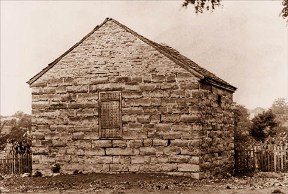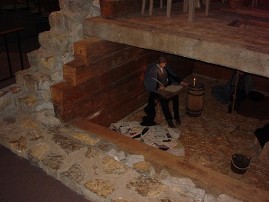Liberty Jail
In October of 1838, mobs and militia antagonistic toward the members of The Church of Jesus Christ of Latter-day Saints laid siege to the Mormon settlement of Far West, Missouri, having received an Extermination Order from Missouri governor Lilburn W. Boggs. The leaders of the Church were given conditions of surrender—the settlement was comprised of only a few hundred people, and the militia of over 3,000 men. The conditions of surrender were as follows: (1) The leaders of the Latter-day Saints were to be taken into custody; (2) the personal property of the Saints was to be confiscated to pay costs, damages, debts suffered by citizens of the state of Missouri; (3) all arms belonging to the Saints were to be confiscated; and (4) all Latter-day Saints had to leave the state. Joseph Smith agreed to meet with militia leaders to avoid bloodshed, but was imprisoned and condemned to be shot without a trial. General Samuel D. Lucas ordered the execution, but General A. W. Doniphan refused, calling the order "cold blooded murder"[1]
Joseph Smith and other leaders were held in Richmond for two weeks while a trial was held. The trial was a travesty of justice, but some of the men were released. On November 30, 1838, Joseph Smith, Hyrum Smith, Sidney Rigdon, Lyman Wight, Alexander McRae, and Caleb Baldwin were taken to Liberty Jail to await another trial. They had been charged with treason against the state of Missouri, an exaggerated and unjust charge. The trial was to begin on March 7, 1839.
Liberty Jail was more like a dungeon. It was twenty-two feet square and had two levels for incarceration, both below the ground. A hole in the floor of the top level was the only way to get to the lower level. The only way out of the jail was through a trap door in the ceiling. The ceilings on both levels were so low that two of the men who were confined there were never able to stand up straight. There were “inner and outer walls which, combined, were four feet thick. Loose rocks were placed between the walls to thwart any attempt at burrowing through” (Neal A. Maxwell, “A Choice Seer,” Ensign, Aug. 1986, 6). The men were forced to stay in Liberty Jail for four months during a bitterly cold winter. There were narrow openings which provided the only light in the prison. Unfortunately, these openings also let in the cold. Conditions were horrible. The prisoners were often sickened by rotten or poisoned food. Along with these deplorable conditions, Joseph and the others also worried for their families and the society of saints who were being driven from their Missouri homes in the midst of winter (see Mormon History: Missouri Period).
Joseph Smith wrote, “We are kept under a strong guard, night and day, . . . our food is scant, uniform, and coarse; we have not the privilege of cooking for ourselves, we have been compelled to sleep on the floor with straw, and not blankets sufficient to keep us warm; and when we have a fire, we are obliged to have almost a constant smoke.”[1]
The men were able to receive visitors who were able to bring them food. Emma Smith visited the jail three times, once bringing Joseph and Emma’s son Joseph III. Hyrum’s wife Mary Fielding Smith visited her husband with their infant son, Joseph F. Smith. This was the first time Hyrum had met his son. But the number of visitors declined when the majority of the Saints were forced from the state.
- O God, where art thou? And where is the pavilion that covereth thy hiding place? How long shall thy hand be stayed, and thine eye, yea thy pure eye, behold from the eternal heavens the wrongs of thy people and of thy servants, and thine ear be penetrated with their cries? ... Remember thy suffering saints, O our God; and thy servants will rejoice in thy name forever (Doctrine & Covenants 121:1-2, 6).
To this cry, the Lord responded:
- My son, peace be unto thy soul; thine adversity and thine afflictions shall be but a small moment; and then, if thou endure it well, God shall exalt thee on high; thou shalt triumph over all thy foes.... Cursed are all those that shall lift up the heel against mine anointed, saith the Lord, and cry they have sinned when they have not sinned before me, saith the Lord, but have done that which was meet in mine eyes, and which I commanded them (Doctrine & Covenants 121:7-8, 16).
In February, Sidney Rigdon was set free, because he became very ill. But the others remained in Liberty Jail. Finally, in April of 1839, the prisoners were taken out of Liberty Jail to be taken to Gallatin, Missouri, for a hearing. After the hearing, the men were told that they would be taken to a jail in Boone County. The guards knew that the Church leaders were neither criminals nor bad men and allowed them to escape. The prisoners then made their way to Illinois.
In 1856 county officials declared the jail unsafe, and it fell into disrepair. On June 19, 1939, Church member Wilford C. Wood purchased the site for $4,000 and transferred the title to the Church for the same cost. The Church sent missionaries to the site to care for the property and welcome tourists. The Church broke ground in 1962 for a new visitors’ center, which now houses a reconstruction of the jail. President Joseph Fielding Smith dedicated the site on September 15, 1963.
Liberty Jail has been restored by the Church of Jesus Christ and is open to the public for tours. There are also artwork and exhibits to see while visiting Liberty Jail.
Other Links
- Church History, "Liberty Jail"
- "Lessons from Liberty Jail," by Jeffrey R. Holland
- Joseph Smith - Home
- Wikipedia - Joseph Smith, Jr. - Wikipedia, the free encyclopedia
- Joseph Smith - Lightplanet
- The Testimony of the Prophet Joseph Smith
- Joseph Smith: Prophet, Revelator, Human; Interview with Richard L. Bushman
- ↑ (Donna Hill, Joseph Smith: The First Mormon, Garden City, NY: Doubleday, 1977).

